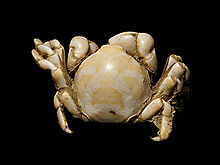|
Crabs of the British IslesLargest and smallest crabs of the British Isles Paromola cuvieri (up to 120 cm claw span) Pinnotheres pisum (up to 4 mm across the carapace) Around 65 species of crab occur in the waters of the British Isles.[1][Note 1] All are marine, with the exception of the introduced Chinese mitten crab, Eriocheir sinensis, which occurs in fresh and brackish water. They range in size from the deep-water species Paromola cuvieri,[3] which can reach a claw span of 1.2 metres (3 ft 11 in),[4] to the pea crab, which is only 4 mm (0.16 in) wide and lives inside mussel shells. FisheriesCommercial crabs in the British Isles Nearly 30,000 t of the edible crab Cancer pagurus is landed in the British Isles every year. 1,500 t of the spider crab Maja brachydactyla is landed in the British Isles every year. More than 500 t of the shore crab, Carcinus maenas, is landed in the British Isles every year. Up to 200 t of the velvet crab, Necora puber, is landed in the British Isles every year. Several species of wild crab are the subject of crab fisheries around the coasts of the British Isles. The most important are the brown crab or edible crab, Cancer pagurus (29,193 t), various swimming crabs (3,180 t), the spider crab Maja brachydactyla (1,565 t), the shore crab or green crab Carcinus maenas (553 t) and the velvet crab Necora puber (193 t). Around 77% of the catch is landed in the United Kingdom, 19% in Ireland, 4% in the Channel Islands, and 1% in the Isle of Man.[Note 2] Species62 species have been directly observed in the waters of the British Isles:[1][Note 3]
Three deep-water species have also been recorded near the British Isles, and are likely to occur in the area. These are:[1]
Notes
References
|





